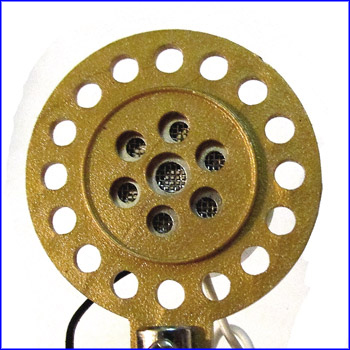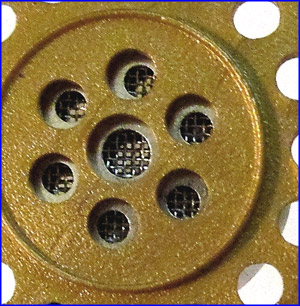MICROPHONES
North Suburban HAMMOND ORGAN Service

Figure 10. The front of a condenser microphone capsule.
On this page we have several views of an actual condenser microphone capsule. It is designed to be considerably more sensitive to sounds arriving from the front rather than from behind. This increases the useful properties of the microphone in that it is much less likely, when recording a musical instrument for example, to pick up unwanted stray sounds that originate elsewhere in the room.
For instance, if you were recording a Hammond organ with a Leslie speaker, and the microphone was aimed at the Leslie, an ignoramus who was babbling nonsense in the background would most likely not have his or her words of pseudo-wisdom included to spoil the recording.
The delicate plastic diaphragm of the condenser microphone must be adequately protected as is evidenced by these two pictures which show the front of the capsule, an internal metal piece with corresponding holes, and then the fine screen within. It is the very low mass of the diaphragm which accounts for the excellent performance of better quality condenser microphones, that is, the wide frequency range and the very flat response graph. Unlike the simple carbon microphones that we considered initially, these condenser mics add very little coloration to the sounds they pick up.

Figure 11. Closeup view of front, condenser microphone capsule assembly.
The entire capsule assembly which we show here is enclosed in the top section of the microphone of figure eight. The outer ring with the holes is part of the design which helps to reduce the amount of sounds that this microphone responds to from the sides and especially from behind. Some microphones are designed to be essentially omni-directional. For some applications they are useful, but more often than not in accurate, high quality recording of musical instruments, rejection of extraneous sounds coming from places other than the instruments of interest is very important. A directional microphone of this type placed on a stage and facing an orchestra, for example will be very good at capturing the sounds of the musicians, and poor at getting audience noises, which is generally the preferred ideal in this type of work.
Page 7. Previous page | Next page